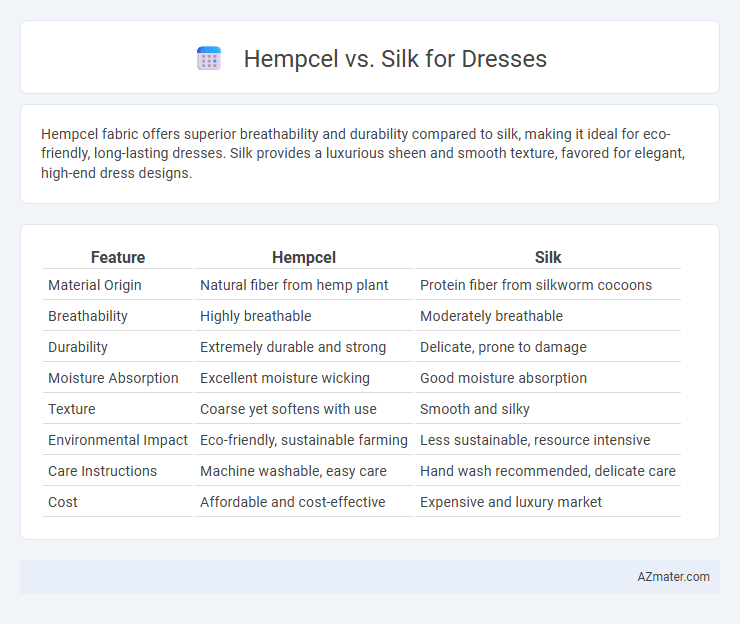Hempcel fabric offers superior breathability and durability compared to silk, making it ideal for eco-friendly, long-lasting dresses. Silk provides a luxurious sheen and smooth texture, favored for elegant, high-end dress designs.
Table of Comparison
| Feature | Hempcel | Silk |
|---|---|---|
| Material Origin | Natural fiber from hemp plant | Protein fiber from silkworm cocoons |
| Breathability | Highly breathable | Moderately breathable |
| Durability | Extremely durable and strong | Delicate, prone to damage |
| Moisture Absorption | Excellent moisture wicking | Good moisture absorption |
| Texture | Coarse yet softens with use | Smooth and silky |
| Environmental Impact | Eco-friendly, sustainable farming | Less sustainable, resource intensive |
| Care Instructions | Machine washable, easy care | Hand wash recommended, delicate care |
| Cost | Affordable and cost-effective | Expensive and luxury market |
Introduction to Hempcel and Silk Fabrics
Hempcel fabric, derived from hemp fiber, offers exceptional durability, natural breathability, and eco-friendly properties, making it a sustainable choice for dress materials. Silk fabric, produced from sericulture, is renowned for its luxurious texture, smoothness, and natural sheen, providing elegance and comfort ideal for formal dresses. Comparing Hempcel and Silk highlights the balance between sustainability and luxury in dress fabric selection.
Origins and Production Processes
Hempcel is derived from the hemp plant, utilizing sustainable agricultural practices that emphasize minimal pesticide use and low water consumption during cultivation. Its production process involves mechanically breaking down hemp fibers into a cellulose-based fabric through environmentally friendly methods, preserving natural strength and breathability. Silk originates from the cocoon of the silkworm, with a labor-intensive harvesting process where cocoons are carefully unraveled to extract fine protein filaments before being spun into luxurious, smooth fabric.
Texture and Appearance Comparison
Hempcel fabric exhibits a coarse texture with a natural, matte finish, providing a rugged and organic appearance that enhances rustic dress designs. In contrast, silk offers a smooth, luxurious texture combined with a lustrous sheen, creating an elegant and refined look suitable for formal attire. The tactile difference between Hempcel's breathable, slightly rough surface and silk's soft, glossy feel distinctly influences the dress's overall aesthetic and comfort.
Comfort and Breathability
Hempcel fabric offers superior breathability and moisture-wicking properties, making it ideal for breathable and comfortable dresses in warm weather. Silk, known for its smooth texture and natural temperature regulation, provides a luxurious feel but may retain heat more than hempcel. While hempcel excels in durability and eco-friendly moisture management, silk delivers elegance with moderate breathability.
Durability and Longevity
Hempcel fabric offers exceptional durability due to its strong, natural fibers that resist wear and tear, making it ideal for long-lasting dresses. Silk, while luxurious and smooth, tends to be more delicate and prone to damage from abrasion and sunlight exposure, reducing its lifespan. Choosing Hempcel ensures greater longevity and sustainable performance in everyday wear compared to the finer yet more fragile silk fabric.
Sustainability and Environmental Impact
Hempcel fabric, derived from hemp fibers, offers exceptional sustainability through its low water usage, rapid growth cycle, and natural resistance to pests, reducing reliance on harmful pesticides. Silk production involves silkworm cultivation and significant resource consumption, including water and energy, alongside challenges in ethical concerns regarding animal welfare. Choosing Hempcel for dresses supports environmentally friendly practices by minimizing carbon footprint and promoting biodegradable, renewable materials.
Maintenance and Care Requirements
Hempcel fabric requires minimal maintenance, as it is naturally resistant to mold, UV rays, and wear, needing only gentle washing in cold water to preserve its durability and texture. Silk demands more delicate care, including hand washing or dry cleaning, avoiding prolonged exposure to sunlight to prevent fading and fabric weakening. Choosing Hempcel over silk simplifies upkeep, offering a sustainable, resilient option that withstands frequent washing without losing its shape or softness.
Cost and Accessibility
Hempcel fabric offers significant cost savings compared to silk, as hemp is a fast-growing, sustainable crop that requires less water and pesticides, making production more affordable and eco-friendly. Silk, derived from silkworms, tends to be more expensive due to labor-intensive harvesting and processing methods, limiting its accessibility to budget-conscious consumers. Hempcel's widespread cultivation supports greater availability in both mass-market and specialty dress materials, while silk remains a premium option in luxury fashion circles.
Style Versatility for Dresses
Hempcel fabric offers natural texture and breathability, making dresses ideal for casual, bohemian, and eco-conscious styles, while silk provides a smooth, lustrous finish suited for elegant, formal, and evening wear. The durability of Hempcel supports versatile, everyday dress designs, whereas silk's delicate drape enhances sophisticated silhouettes and luxurious appeal. Combining Hempcel's earthy tones with silk's vibrant sheen allows designers to create diverse dress options that balance comfort with high-end fashion.
Final Thoughts: Choosing Between Hempcel and Silk
Hempcel offers exceptional durability, breathability, and eco-friendly qualities, making it ideal for sustainable fashion enthusiasts seeking long-lasting dresses. Silk provides a luxurious sheen, softness, and natural temperature regulation, perfect for elegant occasions where a smooth, lightweight fabric enhances comfort and style. Selecting between Hempcel and silk depends on prioritizing sustainability and resilience versus luxury and delicacy in dress materials.

Infographic: Hempcel vs Silk for Dress
 azmater.com
azmater.com